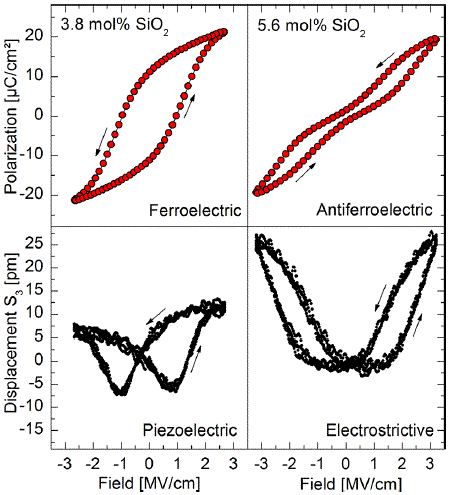=================================================================================
Piezoelectricity is the capability of a certain class of materials to develop an electric charge in response to an applied external mechanical stress, and conversely the production of mechanical deformation by an electric field. Of the 32 point groups, 11 crystal classes are centrosymmetric and thus possess no polar properties. Of the remaining 21 non-centrosymmetric classes, 20 classes show electrical polarity when a stress is applied. Such effect is called the piezoelectric effect. Of the 20 piezoelectric crystal classes, only 10 are polar crystals.
Spontaneous polarization is the property that the polar crystals show electric polarity even without an external electric field. Ferroelectric materials show two or more spontaneous polarization states and can be changed from one state to another by the application of an electric field. In the materials, each region with a uniform polarization state is called a domain.
Ferroelectrics are important materials providing outstanding dielectric, piezoelectric, and ferroelectric properties and are widely used in the field of capacitors, transducers, actuators, filters, sensors, and random access memories. The outstanding piezoelectric behavior of ferroelectric materials can be utilized in both active and passive transducer applications.
Figure 3542a shows the schematic illustration of the different classes of crystal systems and their properties. Even though all ferroelectric materials are pyroelectric, piezoelectric, and non-centrosymmetric, the converse is not true.
|
|
|
|
|
|
|
|
|
|
|
|
|
|
|
|
Non-pyroelectric |
|
|
|
|
Non-ferroelectric |
Figure 3542a. Schematic illustration of the different classes of crystal systems and their properties.
Figure 3542b shows the polarization and piezoelectric displacement measurements of MIM (metal-insulator-metal) capacitor samples with ferroelectric and antiferroelectric Si-doped HfO2 insulators.

Figure 3542b. Polarization (top row) and piezoelectric displacement (bottom row) measurements of MIM (metal-insulator-metal) capacitor samples with ferroelectric (left column) and antiferroelectric (right column) Si-doped HfO2 insulators. [1]
The comparison between the pyroelectrics and ferroelectrics is:
i) Below the Curie temperature, both the pyroelectric and ferroelectric substances develop spontaneous polarizations.
ii) If the temperature is raised back above the Curie temperature, the polarization disappears again for both pyroelectric and ferroelectric substances.
iii) When a reversed electric field is applied, the spontaneous polarization reverses in the ferroelectric substances, but not in the pyroelectric substances.
iv) All ferroelectric materials are piezoelectric (but the reverse is not true).
The direct and converse piezoelectric effects in terms of electric and elastic properties of the materials can be given by,
D = d•E + εσ=C•E --------------------- [3542a]
S = sE=C•σ + d•E --------------------- [3542b]
where,
D -- The dielectric displacement.
σ -- The stress.
S -- The strain.
E -- The electric field.
d -- The piezoelectric coefficient.
sE=C -- The material compliance constant (inverse of the elastic constant) at constant electric field.
εσ=C -- The dielectric constant of the material at constant stress.
In the case of thin films, the intrinsic coupling between the strain and polarization, from the substrate–film lattice mismatch, can be used to tune the electronic configuration and bonding of the films to achieve improved functional properties.
[1] TS Böscke, J Müller, D Bräuhaus, U Schröder, U Böttger, Ferroelectricity in hafnium oxide thin films, Applied Physics Letters, 99, 102903-102903-3, 2011.
|
